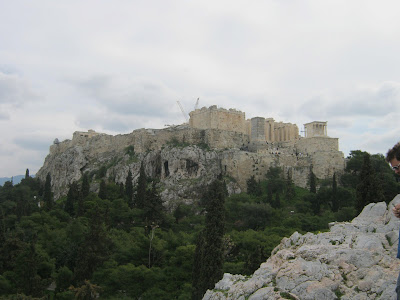For Monday's epigram seminar, I looked at an inscribed Greek epigram carved as graffitti on the leg of one of the famous two statues known as the Colossi of Memnon in Egypt, which we may get to see when we go to Egypt later this month. One of the statues suffered earthquake damage that caused it to "sing" or "whistle" in ancient times and people came from all over to hear it and to leave their mark in the stone.
On Tuesday, we met at the Philopappos Hill to hear Mike's report on the funeral monument of Gaius Julius Antiochus Epiphanes Philopappos (AD 116).
On Wednesday morning, we took the bus to Piraeus to catch a ferry to the island of Salamis. Our first stop was at the Archaeological Museum of Megara.
On Thursday morning we met Leda Costaki at the Kerameikos for our Athens Wall Walk.
On Tuesday, we met at the Philopappos Hill to hear Mike's report on the funeral monument of Gaius Julius Antiochus Epiphanes Philopappos (AD 116).
Then it was down the Philopappos Hill and up to the Pynx, famous meeting place and speaker's platform during the Athenian democracy.
 |
| The very bema, or speaker's platform, where Aeschines and Demosthenes squared off against each other |
On our walk over to the Areopagus, we stopped to have a look at a sanctuary of Pan.
Nik gave his report on the he Areopagus, which is a big rock where, according to tradition, trials for murder were held, though it seems more likely that they were held below the big rock but still up on the hill because the rock is terribly slippery and it's windy up there.
 |
| View of the Stoa of Attalos from the Areopagus |
 |
| View of the Acropolis from the Areopagus |
On Wednesday morning, we took the bus to Piraeus to catch a ferry to the island of Salamis. Our first stop was at the Archaeological Museum of Megara.
While there, Allie gave the history of Megara portion of her report. Then it was out to the Fountain of Theagenes for the other half of Allie's report.
Before heading out to see the Battle of Salamis memorial statue, we stopped at the Salamis museum.
At the statue, Sarah gave her report on the battle while being battered by sideways rain.
Thankfully the weather cleared up before our hike up to the Cave of Euripides.
The cave turned out to be the coolest we've seen yet. It had several hallways leading to many chambers.
At one point, Andrew had everyone turn off their flashlights and it was very, very, very dark, so dark I couldn't see my hand in front of my face.
We walked all over town, peeking in windows, going into basements and car garages, looking at the various bits of preserved city wall from different time periods. It was interesting to see the various methods of conservation used where the modern buildings and the ancient remains were sharing the same space.
 |
| In the Kerameikos, about where the moat once was |
 |
| Behind the motorbike, and through the bars, one can see ancient wall! |
Friday was spent making up the missed Wednesday trip to see the border forts. We began the morning at the Dema Wall.
Then it was on to Phyle where Charles gave his report on the fortifications.
Though not a border fort, we visited the Melietos Monastery next.
After a brief stop at the remains of ancient tower (which is helpfully labeled),
we had lunch and heard the beginning of Flint's report on the border forts at Eleutherai and Aigosthena.
On the way to the second fort of Flint's report, we had a look at an early Christian basilica.
Scaffolding obscured the fort but not the beautiful view of the water.


















































